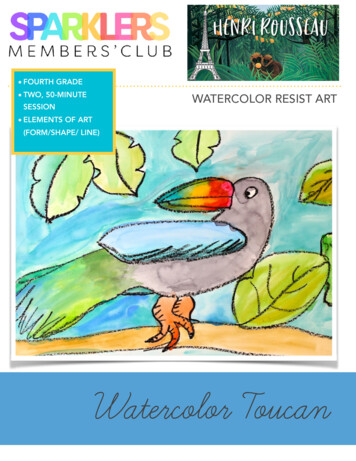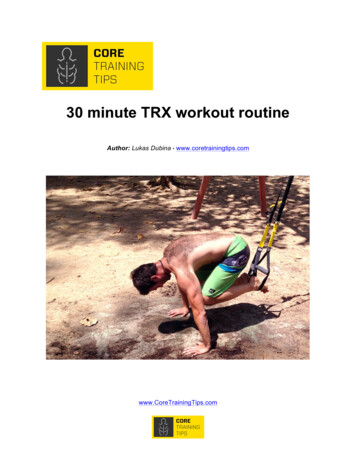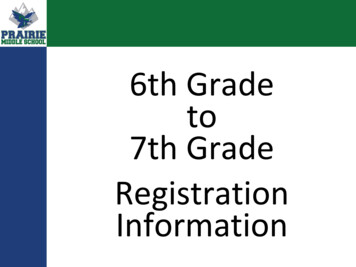
Transcription
FOURTH GRADE TWO, 50-MINUTEWATERCOLOR RESIST ARTSESSION ELEMENTS OF ART(FORM/SHAPE/ LINE)Watercolor Toucan
WATERCOLOR TOUCAN100MINUTES1. Show Visuals of TOUCANS and point out distinguishingfeatures or watch the video and pause of the toucanImage. Sometimes it’s better for a child to draw from aphoto rather than an illustration. (10 minutes)What You’ll Need: 12” x 18” WHITE WATERCOLORPAPER 90 LB TRAY OF WATERCOLOR PAINTS( I like the 16-color set) BLACK OIL PASTELS SMALL BRUSH MEDIUM SIZED BRUSH WATER CONTAINERS PAPER TOWELSDEEP SPACE2. Give each student a piece of watercolor paper and an oilpastel. Watch video for drawing instructions and setdrawing aids on each table. Draw a toucan plus anyfoliage. (40 minutes)3. Show video of watercolor techniques then allow time foryour students to paint with watercolors. Don’t be surprisedif it takes longer than you think! (50 minutes)4. When finished, children can place artwork on drying rack oron a flat surface. The paper may buckle when dry but justplace under a stack of books to flatten.SPARKLE & THE SPARKLERS CLUB2!
ABOUTthe artistABOUTHENRIROUSSEAUHenri Rousseau worked as a toll booth operator in Paris and dreamt of becoming a famouspainter. It wasn’t until he was in his forties that he started painting. After work, he spent manyhours creating his art and joined a group of artists who exhibited their work without theapproval of the official Salon—which at the time, was the only way to be taken serious as aworking artist.Art critics laughed at Rousseau’s self-taught style and said it was simple looking. But otherartists encourage Rousseau who told him that his paintings were very good. Rousseau lovedpainting pictures of the jungle even though he had never been to one. He visited zoo’s andbotanical gardens in Paris and studied the animals and nature around him.Rousseau’s paintings often resembled illustrations in a storybook. He worked on his paintingsvery slowly, inch by inch. Towards the end of his life, a few people paid him to createpaintings for them but his artwork was not recognized until after he died.Now his artwork hangs in the world’s best museums.Exotic Landscape, 1908, oil on canvasDEEP SPACESPARKLE & THE SPARKLERS CLUB3!
DRAWING THE TOUCANInstead of a directed line drawing shown in the video, you can opt to show the studentsthe steps without pausing the videos. Or you can draw the toucan yourself from start tofinish. This way, the kids see the entire process and with the help of the drawing aids andtoucan visuals, they can draw their own toucan.It’s also helpful to show photographs of toucans as children can then interpret the birdon their own. I’ve included an image of a toucan in this PDF file.Demonstrate the various ways you can draw foliage and have the students fill up theempty space with leaves and branches.DEEP SPACESPARKLE & THE SPARKLERS CLUB4!
PAINTING THE TOUCANI find it helpful toisolate parts of thedrawing when itcomes to painting.Often children willpick a color, painta section, move toanother randomspace on thepaper and paintmore colors.If you can slowthem down so theycan be more focused on a specific area, then they tend to do a better job withpainting. Instead of using black paint straight form the pan, use the cover of thepalette to mix water and black paint together for the bird. The grey will be muchmore forgiving than the strong black.DEEP SPACESPARKLE & THE SPARKLERS CLUB5!
DEEP SPACESPARKLE & THE SPARKLERS CLUB6!
DEEP SPACESPARKLE & THE SPARKLERS CLUB7!
DEEP SPACESPARKLE & THE SPARKLERS CLUB8!
DEEP SPACESPARKLE & THE SPARKLERS CLUB9!
Fourth Grade GalleryDEEP SPACESPARKLE & THE SPARKLERS CLUB!10
NATIONAL CORE ARTS STANDARDS - fourth gradeCREATINGXGenerate and conceptualize artistic ideas and work — brainstorm approaches for designXOrganize and develop artistic ideas and work — explore and invent art-makingXRefine and complete artistic work—revise artwork in progress through insights gained fromproblem—set goals and create purposeful and meaningful artworktechniques-care for materials while art-making—document and describe environmentspeers and discussionPresenting/producingAnalyze, interpret and select artistic work for presentation— Analyze how past, presentand emerging technologies have impacted preservation and presentations of artworkDevelop and refine artistic work for presentation — Analyze the various considerations forpresenting and protecting work in all settings and formsConvey meaning through the presentation of artistic work — compare and contrastpurposes of art museums, etc. and the types of personal experiences they provideRespondingPerceive and analyze artistic work- compare responses to artwork after experiencing themedium analyze messages in visual imageryXInterpret intent and meaning in artistic work — interpret art by referring to contextual infoXApply criteria to evaluate artistic work— apply one set of criteria to evaluate more thanand analyzing relevant subject matter, characteristics and mediaone work of artConnectingXSynthesize and relate knowledge and personal experiences to make art- create works ofXRelate artistic ideas and works with societal, cultural and historical context to deepenart that reflect community cultural traditionsunderstandingDEEP SPACESPARKLE & THE SPARKLERS CLUB!11
I can statements for toucans Today I will learn about LINE and SPACE, so that I CAN draw a toucan. I’ll know I have it when Ihave combined line and shapes to create a toucan. Today I will learn how to paint with WATERCOLORS. I will learn how to use RESIST and how tomingle paint colors. Today I will learn about CONTRAST, so that I CAN paint my design making sure the toucan standsout from the background.Common Core STANDARDS for toucansCCSS.ELA-Literacy.W.4.1Write opinion pieces on topics or texts, supporting a point of view with reasons and information.After students finish their art, you can have them fill out the artist statement worksheet (located inResources). This information leads them to reflect on the process of art making while forming anopinion about their own work based on the processes used, materials used, inspirations, etc.CCSS.ELA-Literacy.L.4.1Demonstrate command of the conventions of standard English grammar and usage when writing orspeaking.You can communicate to students that using conventions of standard English grammar when writingtheir answers to the artist statement worksheet should be emphasized. This is a wonderful way tohelp students see cross curricular connections between subjects!CCSS.Math.Content.4.G.A.3Recognize a line of symmetry for a two-dimensional figure as a line across the figure such that thefigure can be folded along the line into matching parts. Identify line-symmetric figures and drawlines of symmetry.As students draw their leaves, you can have a discussion about the stem representing a line ofsymmetry. Have them explain what symmetry means and whether or not their leaves fall into thecategory.DEEP SPACESPARKLE & THE SPARKLERS CLUB!12
ASSESSMENT CHECKLISTMain Ideas from:WATERCOLOR TOUCANStudent Name:Did the students follow directions whendrawing their toucan?Did the student use watercolor resisteffectively?Did the student achieve contrast?DEEP SPACESPARKLE & THE SPARKLERS CLUB!13
Rousseau's paintings often resembled illustrations in a storybook. He worked on his paintings very slowly, inch by inch. Towards the end of his life, a few people paid him to create paintings for them but his artwork was not recognized until after he died. Now his artwork hangs in the world's best museums. ABOUT the artist











